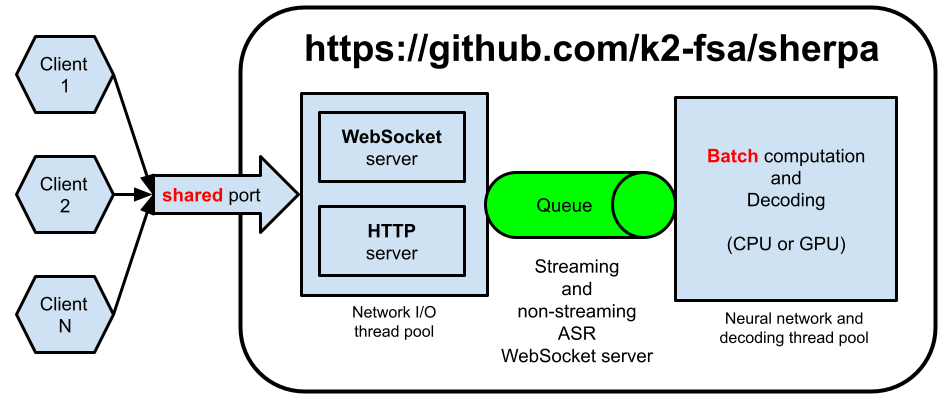本文介绍最近在 sherpa 中新增的使用 C++ 实现基于 WebSocket
的语音识别服务。只涉及设计思想、使用方法和测试结果。
具体的代码实现请参考如下链接:
https://github.com/k2-fsa/sherpa/tree/master/sherpa/cpp_api/websocket
注:实现上,我们选择 websocketpp 和 asio, 使用
异步编程的方式。
不依赖 boost。
不依赖
boost。不依赖
boost。
具体架构如下图所示。
流式识别和非流式识别采用同一架构。
我们使用了两个线程池 (由 asio 管理):
- (1)通信线程池
Network I/O thread pool:负责收发数据,处理与client的通信。 - (2)识别线程池
Neural network and decoding thread pool:负责神经网络计算和解码,即AM和decoder。
该架构支持同时有多个 client 发送请求的情况,且使用同一端口同时支持
HTTP 和 WebSocket 两种服务。
注:目前
HTTP服务只负责提供下述链接中的静态文件给客户端。
当收到 client 发送的数据时,我们首先会把它放入到一个队列里面,然后使用
asio::post 通知识别线程池, 由 asio 调度识别线程池里的线程进行处理。
当识别线程池里的线程处理队列里的请求时,如果发现有多个请求,会把这些请求
打包成一个 batch,然后以 batch 的方式进行处理。用户可以用 --max-batch-size
命令行参数限制 batch size 的大小。当识别完成后,我们也使用 asio::post,
通知通信线程把识别结果返回给客户端。
使用 PyTorch 进行底层计算,用户只需通过命令行参数 --use-gpu=false
或者 --use-gpu=true 来选择是使用 CPU 还是 GPU。
注:目前只实现了对单个
GPU的支持。如果系统中有多个GPU, 默认使用GPU0。 用户可以通过环境变量CUDA_VISIBLE_DEVICES指定使用哪个GPU。
该架构有如下优势:
-(1)省资源。使用固定大小的线程池。不是来一个请求,就创建一个新的线程。
-(2) 扩容方便。用户可以通过命令行参数 --num-io-threads 和 --num-work-threads
指定通信线程池和识别线程池的大小。依据不同的负载,使用不同的值。
-(3)支持 batch 处理。当有多个用户同时请求时,支持把这些请求打包成一个 batch 进行识别。
-(4)一键切换 CPU 或者 GPU。用户通过命令行参数 --use-gpu 进行选择。
本节介绍具体的使用方法。
假设你已经安装好了 PyTorch, k2 和 kaldifeat。
编译 sherpa 的命令如下:
git clone https://github.com/k2-fsa/sherpa
cd sherpa
mkdir build
cd build
cmake -DCMAKE_BUILD_TYPE=Release ..
make -j编译好后,生成如下文件:
build$ ls -lh bin/*websocket*
-rwxr-xr-x 1 kuangfangjun root 12M Oct 30 10:35 bin/offline_websocket_client
-rwxr-xr-x 1 kuangfangjun root 15M Oct 30 10:35 bin/offline_websocket_server
-rwxr-xr-x 1 kuangfangjun root 12M Oct 30 10:35 bin/online_websocket_client
-rwxr-xr-x 1 kuangfangjun root 13M Oct 30 10:35 bin/online_websocket_client_from_microphone
-rwxr-xr-x 1 kuangfangjun root 16M Oct 30 10:35 bin/online_websocket_server额,文件有点大。都大于 10 MB 了。
strip 一下,文件大小如下:
build$ strip bin/*websocket*
build$ ls -lh bin/*websocket*
-rwxr-xr-x 1 kuangfangjun root 435K Oct 30 10:36 bin/offline_websocket_client
-rwxr-xr-x 1 kuangfangjun root 439K Oct 30 10:36 bin/offline_websocket_server
-rwxr-xr-x 1 kuangfangjun root 431K Oct 30 10:36 bin/online_websocket_client
-rwxr-xr-x 1 kuangfangjun root 439K Oct 30 10:36 bin/online_websocket_client_from_microphone
-rwxr-xr-x 1 kuangfangjun root 427K Oct 30 10:36 bin/online_websocket_server小于 500 KB, 还可以接受。
每一个生成的 binary, 都支持使用 --help 查看使用帮助。在介绍它们的使用
方法之前,我们先下载预训练模型,以便测试。
中文非流式模型:
cd /path/to/sherpa
GIT_LFS_SKIP_SMUDGE=1 git clone https://huggingface.co/luomingshuang/icefall_asr_wenetspeech_pruned_transducer_stateless2
cd icefall_asr_wenetspeech_pruned_transducer_stateless2
git lfs pull --include "exp/cpu_jit_epoch_10_avg_2_torch_1.7.1.pt"英文非流式模型:
cd /path/to/sherpa
git lfs install
git clone https://huggingface.co/csukuangfj/icefall-asr-librispeech-pruned-transducer-stateless3-2022-05-13英文流式模型:
cd /path/to/sherpa
GIT_LFS_SKIP_SMUDGE=1 git clone https://huggingface.co/Zengwei/icefall-asr-librispeech-conv-emformer-transducer-stateless2-2022-07-05
cd icefall-asr-librispeech-conv-emformer-transducer-stateless2-2022-07-05
git lfs pull --include "exp/cpu-jit-epoch-30-avg-10-torch-1.10.0.pt"注:目前只实现了 ConvEmformer 的流式模型。
启动服务器:
cd /path/to/sherpa/build
./bin/online_websocket_server \
--nn-model=../icefall-asr-librispeech-conv-emformer-transducer-stateless2-2022-07-05/exp/cpu-jit-epoch-30-avg-10-torch-1.10.0.pt \
--tokens=../icefall-asr-librispeech-conv-emformer-transducer-stateless2-2022-07-05/data/lang_bpe_500/tokens.txt \
--port=6006 \
--use-gpu=false \
--num-io-threads=1 \
--num-work-threads=2启动客户端 (识别单条音频)
cd /path/to/sherpa/build
./bin/online_websocket_client \
--server-ip=127.0.0.1 \
--server-port=6006 \
../icefall-asr-librispeech-conv-emformer-transducer-stateless2-2022-07-05/test_wavs/1089-134686-0001.wav启动客户端 (麦克风录音,实时识别)
cd /path/to/sherpa/build
./bin/online_websocket_client_from_microphone \
--server-port=6006 \
--server-ip=127.0.0.1识别效果,请见下述视频:
bilibili 视频链接如下:
启动服务器:
./bin/offline_websocket_server \
--nn-model=../icefall_asr_wenetspeech_pruned_transducer_stateless2/exp/cpu_jit_epoch_10_avg_2_torch_1.7.1.pt \
--tokens=../icefall_asr_wenetspeech_pruned_transducer_stateless2/data/lang_char/tokens.txt \
--num-io-threads=2 \
--num-work-threads=5 \
--use-gpu=false启动客户端:
./bin/offline_websocket_client \
--server-ip=127.0.0.1 \
--server-port=6006 \
../icefall_asr_wenetspeech_pruned_transducer_stateless2/test_wavs/DEV_T0000000000.wav下面我们测试非流式识别的 RTF。
- 测试集:LibriSpeech test-clean, 5.4 小时
我们分别使用 GPU 和 CPU 进行测试。
准备测试数据:
cd /path/to/sherpa
wget -q --no-check-certificate https://www.openslr.org/resources/12/test-clean.tar.gz
tar xf test-clean.tar.gz
rm test-clean.tar.gz
ls -lh LibriSpeech
mkdir -p data/manifests
lhotse prepare librispeech -j 2 -p test-clean $PWD/LibriSpeech data/manifests
ls -lh data/manifests
lhotse cut simple \
-r ./data/manifests/librispeech_recordings_test-clean.jsonl.gz \
-s ./data/manifests/librispeech_supervisions_test-clean.jsonl.gz \
test-clean.jsonl.gz启动服务器:
cd /path/to/sherpa/build
./bin/offline_websocket_server \
--nn-model=../icefall-asr-librispeech-pruned-transducer-stateless3-2022-05-13/exp/cpu_jit.pt \
--tokens=../icefall-asr-librispeech-pruned-transducer-stateless3-2022-05-13/data/lang_bpe_500/tokens.txt \
--num-io-threads=2 \
--num-work-threads=4 \
--max-batch-size=100 \
--use-gpu=true注: 我们使用 32 GB 的
V100GPU进行测试。
启动客户端:
cd /path/to/sherpa
time python3 ./sherpa/bin/pruned_transducer_statelessX/decode_manifest.py \
--server-addr 127.0.0.1 \
--server-port 6006 \
--manifest-filename ./test-clean.jsonl.gz \
--num-tasks 400注:我们建立 400 个连接,同时发送数据。每个连接发送一条音频进行解码。收到 识别结果后,再发送下一条。
最终的 RTF 为 0.0030, WER 为 2.04。
注:
RTF的计算方法为把所有数据解码完所需的时间,除以数据的总时长。
我们使用 GitHub actions 提供的机器进行测试。机器配置 如下:
- 2-core CPU (x86_64)
- 7 GB of RAM
- 14 GB of SSD space
启动服务器:
cd /path/to/sherpa/build
./bin/offline_websocket_server \
--nn-model=../icefall-asr-librispeech-pruned-transducer-stateless3-2022-05-13/exp/cpu_jit.pt \
--tokens=../icefall-asr-librispeech-pruned-transducer-stateless3-2022-05-13/data/lang_bpe_500/tokens.txt \
--num-io-threads=1 \
--num-work-threads=2 \
--max-batch-size=1 \
--use-gpu=false启动客户端:
cd /path/to/sherpa
time python3 ./sherpa/bin/pruned_transducer_statelessX/decode_manifest.py \
--server-addr 127.0.0.1 \
--server-port 6006 \
--manifest-filename ./test-clean.jsonl.gz \
--num-tasks 100最终的 RTF 为 0.0548, WER 为 2.04。
详细结果,可以参考如下链接:
https://github.com/k2-fsa/sherpa/actions/runs/3349799955/jobs/5550137555
本文介绍了 sherpa 中 WebSocket 语音识别服务的设计思想及使用方法。
并在 GPU 和 CPU 上对 RTF进行了测试。
注:如果有疑问,请关注
新一代 Kaldi公众号,加入新一代 Kaldi 微信交流群进行讨论。
